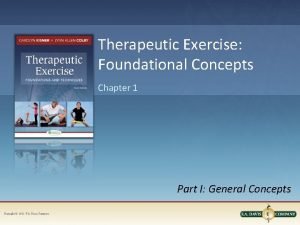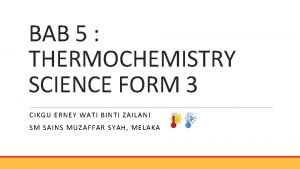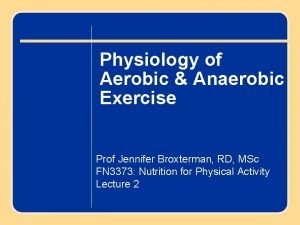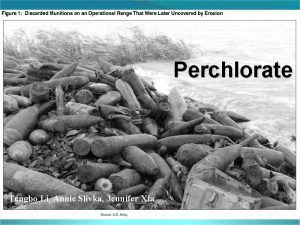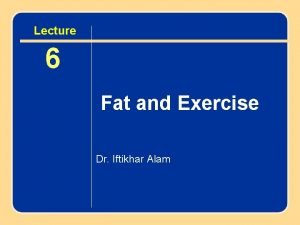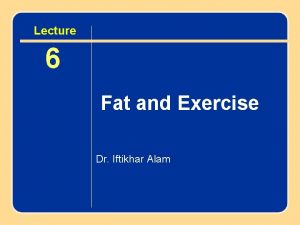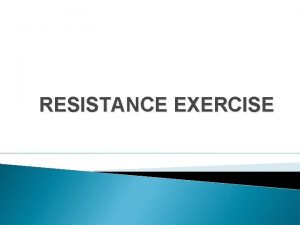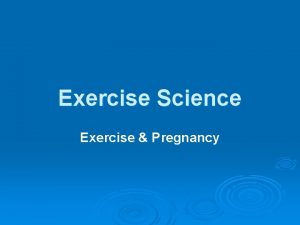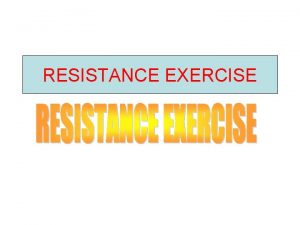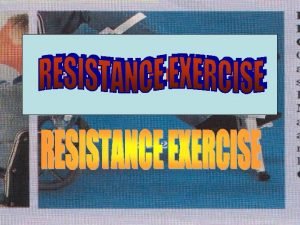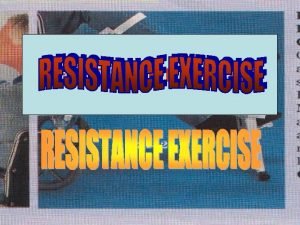chapter 33 Fatas asaa Fuelfor Exercise Prof Jennifer








































- Slides: 40

chapter 33 Fatas asaa. Fuelfor Exercise Prof Jennifer Broxterman, RD, MSc FN 3373: Nutrition for Physical Activity Lecture 3 Author name here for Edited books

Introduction to Fat & Athletic Performance • Fat is important for athletic performance and good health • Primary fuels for exercise: fat & CHO – Both fuels are oxidized simultaneously – Proportion of each dependent on: • • Meal prior to exercise Energy fed during exercise The duration, intensity, and type of exercise Athlete’s fitness level – Fat becomes the primary source of fuel during endurance exercise

Introduction to Fat & Athletic Performance • AMDR: 20 -35% of kcal from fat – Because of the role CHO plays in replenishing glycogen, athletes should consume less fat and more CHO than sedentary individuals – Endurance athletes: moderate-to-low-fat diets (2025% of kcal from fat) – Ultralow-fat diets (<15% of kcal from fat) are not advantageous to health or performance and are difficult to follow

Function, Classification, and Dietary Sources of Fat

Important Roles of Fat • Fat is essential to life: – Primary source of energy at rest and during exercise – Efficient way to store extra energy in a small space • Fat is twice as energy dense as CHO and protein (9 kcal/ gram versus 4 kcal/ gram) – Provides essential FAs (linoleic and α-linolenic acid) and fat-soluble vitamins (A, D, E, K)

Important Roles of Fat • Fat is essential to life: – Part of the structural component of cell membranes and part of the brain and spinal cord tissue – Keeps the skin and other tissues soft & pliable – Pads the body and protects internal organs – Tastes good; makes food more palatable by adding texture & flavour

Classification of Dietary Fats • Dietary fats can be classified based on their: – – Structure or chain length Level of saturation Shape (i. e. cis vs. trans) Commercial processing that the fat has undergone • Hydrogenation

Figure 3. 1 Saturation & Structural Differences between Fatty Acids

Essential Fatty Acids • EFAs: – Linoleic acid (omega-6) • Food sources: vegetable oils (sunflower, safflower, corn, soy, peanut) • AI: ~5 -10% of total energy • Males: 17 g/day, females: 12 g/day – α-linolenic acid (omega-3) • Food sources: leafy green vegetables, soy, seafood, canola oil, flaxseed, walnuts • AI: ~0. 6 -1. 2% of total energy • Males: 1. 6 g ALA/day, females 1. 1 g ALA/day

Omega-3 Fatty Acids • CFG: Aim to eat fish 2 x/week (75 g per serving) • International Fish Oil Standards: http: //www. nutrasource. ca/ifos/Consumer. Report. aspx

Fats in Foods • Triglycerides: dietary fat is found primarily in the form of triglycerides (triacylglycerols) – 3 FAs attached to a glycerol backbone • Foods also contain other forms of lipids: – Cholesterol, phospholipids, sterols • Animal fats: provide ~40 -60% of their energy as SFAs and 30 -50% as MUFAs and PUFAs • Plant fats: provide ~10 -20% of their energy as SFAs with the rest from MUFAs & PUFAs

Fats in Foods • Visible Fats – Obvious fats that are easy to spot in foods – E. g. oils, butter, cream, margarine, mayonnaise, fats on meats • Invisible Fats – Incorporated into prepared foods and are not as easily discernible – Majority of fat in most people’s diet comes from invisible fats – E. g. cookies, cakes, croissants, casseroles

Nutrition Labels: Fat Terminology • Fat free: less than 0. 5 g of fat per serving • Low fat: 3 g or less of fat per serving • Reduced or less fat: at least 25% less fat as compared to a standard serving • Light: one-third fewer calories or 50% less fat as compared with a standard serving size

Fat Replacers (Appendix B 2) • Carbohydrate-based fat replacers: – Dextrins, maltodextrins, tapioca dextrin, modified food starch – Oatrim – Z-Trim – Polydextrose – Microcrystalline cellulose – Gums

Fat Replacers (Appendix B 2) • Protein-based fat replacers: – Simplesse • Fat-based fat replacers: – Olestra (Olean) – Salatrim (Benefat)

Body Fat Reserves and Dietary Fat Intake

Body Fat Reserves • Compared to protein & CHO stores, the body’s fat reserves are almost unlimited • Total amount of energy stored as fat varies with an individual’s size and body fat percentage

Average Body Composition • Women: greater fat tissue is normal & necessary for reproduction

Body Fat Percentage

Dietary Fat Guidelines for Canadians • AMDR: aim for 20 -35% of total energy intake coming from fat • Saturated fat: limit to <10% of total energy intake • Link between: – High dietary fat intake and risk of obesity, coronary heart disease, and some forms of cancer

Dietary Fat Intake of Active Individuals • Intake of fat is variable depending on the sport and gender of the athlete – Athletes typically report consuming about 35% of their energy from fat (Hawley et al. 1995) • Endurance sports: – E. g. running, cycling, x-country skiing – Report lower fat intakes and higher CHO intakes than sprinters and field event athletes • Athletes with weight concerns: – E. g. sports that have ‘weigh ins’, sub-clinical EDs – Lower fat intakes, esp. during periods of kcal restriction

Fat Metabolism During Exercise

Fat as a Fuel During Exercise • Fat is a major energy source during exercise – The ability to mobilize and use stored fat during exercise can improve exercise performance • Fat can be mobilized from the following sources: – – Muscle fat Adipose tissue fat Blood lipoproteins Fat consumed during exercise

Adipose Fat Tissue • Adipose fat tissue contains the largest reservoir of stored energy within the body • Steps involved to use fat during exercise: 1. 2. 3. 4. 5. 6. 7. Breakdown of TGs to FFAs and glycerol Mobilization and transport of FFAs within the fat cell Transport of the FFAs out of the fat cell to the blood Transport of the FFAs into the muscle cell Transport of the FFAs to the muscle mitochondria Oxidation to energy via the tricarboxylic acid (TCA) cycle

Lipolysis • Lypolysis: the breakdown of fat in the adipose or muscle tissue to FFAs and glycerol – Metabolic process is initiated when the sympathetic nervous system stimulates production of hormonesensitive lipase (HSL) and epinephrine

Figure 3. 4

Re-Esterification • Re-esterification: FAs released during the process of lipolysis are re-esterified if they are not needed for energy at that time – 3 FFAs + glycerol are transformed back into a TG – Intracellular recycling: re-esterification takes place within the adipose cell – Extracellular recycling: re-esterfication takes place outside of the adipose cell (e. g. in the liver) – During exercise, re-esterification is suppressed at the same time that the rate of lipolysis is accelerated

Hormonal Control of Lypolysis • Sympathetic nervous system – Strong stimulator of lipolysis – Hormones: epinephrine and norepinephrine rise dramatically upon the initiation of exercise – Signal the breakdown of stored fat (in adipose & muscle tissue) and carbohydrate (in liver & muscle glycogen), making these fuels available to the working muscles • Other hormones that stimulate lipolysis: – Growth hormone, cortisol, thyroid stimulating hormone

Hormonal Control of Lipolysis • Insulin: – Strongest inhibitor of lipolysis by decreasing the amount of active hormone-sensitive lipase (HSL) – During exercise or times of starvation, when the need for fat as an energy source is high, insulin levels are typically low and lipolysis is high • Blood glucose (BG) concentrations: – Independent of insulin, any increase in BG concentrations (i. e. feeding CHO during exercise) suppresses lipolysis, changing the mix of fuels used for energy during exercise

Intramuscular Fat • Fat stored within skeletal muscle appears to be an important energy source during exercise – Advantage: having TGs stored within muscle means that the fat is close to the mitochondria, the site of lipid oxidation and energy production, without requiring transport through the blood • Amount of intramuscular fat stored depends on: – Muscle fibre type – Nutritional status – Type of physical activity engaged in

Oxidation of Intramuscular Fat • Amount of intramuscular fat oxidized during exercise has not been well determined – Estimated that endurance exercise decreases intramuscular fat concentrations from 25% to 50% – The contribution of intramuscular fat breakdown to total fat oxidation during exercise may be 5% to 35%, depending on the study • Differences arise due to: subject fitness levels, exercise protocols, study methodology

Figure 3. 6

Blood Lipids

Blood Lipids • Lipoproteins: transport fat in the blood, can be used for energy during exercise – 2 lipoproteins highest in TGs: chylomicrons & VLDL • Lipoprotein lipase (LPL): the enzyme that is responsible for cleaving the FAs from the TG molecules in blood lipoproteins • Amount of energy obtained from blood lipids is generally small

Enhancement of Fat Oxidation

Fat Burning During Exercise • Exercise training: – Enables a person to work harder (higher oxygen uptake) while deriving more energy from fat and less from CHO – Physiological adaptations to exercise: • • • Increased # of mitochondria enhances TCA cycle, FA oxidation, and the electron transport system Increased TG storage intramuscularly Increased capillary density of muscle, which improves blood flow and the exchange of FFAs and oxygen

Long-Chain Triglycerides vs. Medium-Chain Triglycerides

Long-Chain Triglycerides • Long-chain triglycerides (LCTs): – Slow gastric emptying, stay in the GI tract longer, and enter the blood stream more slowly – LCT consumption is generally not recommended during intense exercise lasting less than 4 hours – May be appropriate for long-lasting activity (i. e. ultramarathon, multiday event, all-day hike)

Medium-Chain Triglycerides • Medium-chain triglycerides (MCTs): – Glycerol backbone with 3 MCFAs (6 -12 carbons) – Smaller size alters the way MCTs are digested, transported, & utilized for energy within the body • Rapidly exit the stomach and quickly diffuse across the gut (use less pancreatic lipase and bile salts) • Quickly enter the portal vein bound to albumin, where they are transported to the liver • Are oxidized rapidly for energy (vs. stored as adipose tissue) • MCFAs are not dependent on carnitine for transport into the mitochondria

Medium-Chain Triglycerides • MCTs & athletic performance: – MCTs do not significantly spare muscle glycogen – Total fat oxidation generally remains the same when MCTs are consumed either before or during exercise – MCTs may spare endogenous fat stores – MCTs have negative gastrointestinal side effects – MCTs are very expensive – Overall: MCT ingestion either before or during exercise does not appear to spare muscle glycogen or improve exercise performance
 Therapeutic exercise chapter 1 mcqs
Therapeutic exercise chapter 1 mcqs Chapter 13 exercise and lifelong fitness
Chapter 13 exercise and lifelong fitness Chapter 24 exercise and activity
Chapter 24 exercise and activity Thermochemistry form 3 exercise
Thermochemistry form 3 exercise Chapter 28 oral diagnosis and treatment planning
Chapter 28 oral diagnosis and treatment planning Anaerobic exercise physiology
Anaerobic exercise physiology Jennifer hanna md
Jennifer hanna md Dr kungle
Dr kungle Jennifer mastrianni
Jennifer mastrianni En el gráfico se aprecia la torre inclinada de pisa
En el gráfico se aprecia la torre inclinada de pisa Jennifer weingarten
Jennifer weingarten State of indiana employee benefits
State of indiana employee benefits Jennifer bruton
Jennifer bruton Jennifer kean
Jennifer kean What does jennifer peters do on a typical day? (site 1)
What does jennifer peters do on a typical day? (site 1) Jennifer hatcher dvm age
Jennifer hatcher dvm age Jennifer martinez niehs
Jennifer martinez niehs Gonpichuelo
Gonpichuelo Jennifer hain teper
Jennifer hain teper Nava
Nava Jennifer xia
Jennifer xia Msn
Msn Jennifer lehmer
Jennifer lehmer Brenton diaz
Brenton diaz Jennifer uhler
Jennifer uhler Background of poem for my mother by jennifer davids
Background of poem for my mother by jennifer davids De donde vengo proyecto de vida
De donde vengo proyecto de vida Lilac zihui zhao
Lilac zihui zhao Lara owens geothermal energy
Lara owens geothermal energy Jennifer livingston
Jennifer livingston Jennifer drysdale
Jennifer drysdale Dr nosheen ishaque
Dr nosheen ishaque Dr jenny atas
Dr jenny atas Sherman oaks jennifer aniston
Sherman oaks jennifer aniston Larve de phrygane milieu de vie
Larve de phrygane milieu de vie Jennifer coffey engaged
Jennifer coffey engaged Jennifer de winter
Jennifer de winter Jennifer solari
Jennifer solari Jennifer nutefall
Jennifer nutefall Jennifer nyland
Jennifer nyland How to draw the brachial plexus
How to draw the brachial plexus
